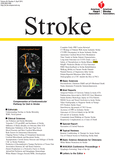Stroke:血管内卒中治疗合用替罗非班增加脑出血风险
2013-04-09 Stroke 丁香园
使用IIb/IIIa抑制剂替罗非班与严重出血并发症和机械性取栓后转归的相关性尚不清楚。为此,德国Heidelberg大学神经科的Lars Kellert博士等人进行了一项研究,研究结果在线发表在2013年3 月5日的Stroke杂志上。研究结果显示:血管内卒中治疗,联合使用糖蛋白IIb-IIIa抑制剂替罗非班与致死性颅内出血风险增加及转归差相关。研究中纳入了前瞻性收集的连续病例,这些病例是在200
使用IIb/IIIa抑制剂替罗非班与严重出血并发症和机械性取栓后转归的相关性尚不清楚。为此,德国Heidelberg大学神经科的Lars Kellert博士等人进行了一项研究,研究结果在线发表在2013年3 月5日的Stroke杂志上。研究结果显示:血管内卒中治疗,联合使用糖蛋白IIb-IIIa抑制剂替罗非班与致死性颅内出血风险增加及转归差相关。
研究中纳入了前瞻性收集的连续病例,这些病例是在2006至2011年进行机械性取栓的急性缺血性卒中患者。
研究结果显示:162位患者中,有128位为前循环卒中,34位为后循环卒中。前循环卒中的128位患者中有30位另外加用替罗非班,后循环卒中的34位患者中有20位另外加用替罗非班。替罗非班的应用没有增加再通率。整个队列中,替罗非班治疗的患者致死性颅内出血发生率较高 (12.0% vs 2.7%; P=0.03),前循环卒中患者中,替罗非班治疗的患者致死性颅内出血的发生率也较高(13.3% vs 3.1%; P=0.05)。logistic回归示:年龄 (优势比:1.17; 95%可信区间:1.00–1.37; P=0.05)和替罗非班治疗(优势比:3.03; 95%可信区间:1.50–4.05; P=0.04)是颅内出血的独立预测因素。除NISS得分(优势比:1.08; 95%可信区间:1.00–1.17; P=0.05)外,替罗非班治疗也是转归差的独立预测因素 (优势比:6.60; 95%可信区间:1.06–41.52; P=0.04)。
该研究发现:血管内卒中治疗,联合使用糖蛋白IIb-IIIa抑制剂替罗非班与致死性颅内出血风险增加及转归差相关。
与脑出血相关的拓展阅读:
- ANN NEUROL:防止脑出血新方法
- Neurology:常服抗抑郁药或增加脑出血风险
- STROKE:采用MIS治疗自发性幕上脑出血获益更多
- Neurology:重度饮酒使脑出血发病提前14年
- Neurology:脑出血预后与脑内CRP水平相关
- JAMA:静脉溶栓治疗不增加华法林使用者脑出血风险 更多信息请点击:有关脑出血更多资讯

Endovascular Stroke Therapy: Tirofiban Is Associated With Risk of Fatal Intracerebral Hemorrhage and Poor Outcome.
BACKGROUND AND PURPOSE
To investigate the relationship between severe bleeding complications and outcome after mechanical thrombectomy with or without glycoprotein-IIb/IIIa inhibitor tirofiban treatment.
METHODS
The study included prospectively collected data of consecutive patients with acute ischemic stroke in whom mechanical thrombectomy was perfomed in the years 2006 to 2011.
RESULTS
Of 162 patients, 128 patients had anterior circulation stroke, and 34 patients had posterior circulation stroke. Additional treatment with tirofiban was given to 30 of 128 patients with anterior circulation stroke and to 20 of 34 patients with posterior circulation stroke. Treatment with tirofiban did not influence recanalization rates. Fatal intracerebral hemorrhage occurred more frequently in tirofiban-treated patients in the entire cohort (12.0% vs 2.7%; P=0.03) and in tirofiban-treated patients with anterior circulation stroke (13.3% vs 3.1%; P=0.05). Logistic regression found age (odds ratio, 1.17; 95% confidence interval, 1.00-1.37; P=0.05) and tirofiban treatment (odds ratio, 3.03; 95% confidence interval, 1.50-4.05; P=0.04) to be independent predictors for fatal intracerebral hemorrhage. Tirofiban treatment was also an independent predictor for poor outcome (odds ratio, 6.60; 95% confidence interval, 1.06-41.52; P=0.04) in addition to National Institute of Health Stroke Scale (odds ratio, 1.08; 95% confidence interval, 1.00-1.17; P=0.05).
CONCLUSIONS
In endovascular stroke therapy, additional treatment with the glycoprotein-IIb/IIIa inhibitor tirofiban is associated with increased risk of fatal intracerebral hemorrhage and poor outcome.
本网站所有内容来源注明为“梅斯医学”或“MedSci原创”的文字、图片和音视频资料,版权均属于梅斯医学所有。非经授权,任何媒体、网站或个人不得转载,授权转载时须注明来源为“梅斯医学”。其它来源的文章系转载文章,或“梅斯号”自媒体发布的文章,仅系出于传递更多信息之目的,本站仅负责审核内容合规,其内容不代表本站立场,本站不负责内容的准确性和版权。如果存在侵权、或不希望被转载的媒体或个人可与我们联系,我们将立即进行删除处理。
在此留言








